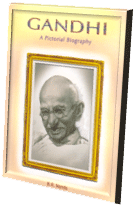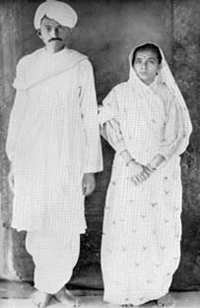
P.O. SEVAGRAM, DIST.WARDHA 442102, MS, INDIA. Phone: 91-7152-284753
FOUNDED BY MAHATMA GANDHI IN 1936
BIOGRAPHY OF GANDHI
GANDHI - A PICTORIAL BIOGRAPHY
by Shri B. R. Nanda

GANDHI
- A PICTORIAL BIOGRAPHY
Shri B. R. Nanda
Table of Contents
- About Gandhi
- Childhood
- Off To England
- Briefless Barrister
- In The 'Dark Continent'
- The Young Politician
- Satyagraha Struggle In South Africa
- The Making Of The Mahatma
- Return To India
- Gandhi's Ashram
- World War I
- Rowlatt Bills
- Nonviolent Non-cooperation
- Arrest And Imprisonment
- Reaction And Recovery
- Declaration Of Complete Independence
- Gandhi-Irwin Pact
- Round Table Conference
- In London
- Resumption Of Struggle
- Campaign Against Untouchability
- A New Deal For The Village
- The New Constitution
- Hindu-Muslim Antagonism
- Nonviolence In A Violent World
- Cripps Mission
- "Quit India"
- Simla Conference
- Cabinet Mission
- Communal Conflagration
- Partition of India
- Mission of Peace
- The End
- Gandhi and Nonviolence
About This Book
This is the first pictorial biography of Gandhi in which the narrative-concise, readable and incisive is illustrated with contemporary photographs and facsimiles of letters, newspaper reports and cartoons, adding up to a fascinating flash-back on the life of Mahatma Gandhi and the struggle for Indian freedom led by him. There is a skilful matching in this book of text and illustrations, of description and analysis and of concrete detail and large perspective. This pictorial biography will revive many memories in those who have lived through the Gandhian era; it should also be of interest to the post-independence generation.
About Author
Shri B. R. Nanda - former Director, Nehru Memorial Museum and Library, New Delhi. His full-scale biography of Mahatma Gandhi has been published in India, Britain and the U.S.A. and translated into French, Spanish, Italian and several other languages
Chapter-8 : Return To India

A hero's welcome awaited Gandhi when he landed on January 9, 1915, at the Apollo Bunder in Bombay. Three days later he was honored by the people of Bombay at a magnificent reception in the palatial house of a Bombay magnate Jehangir Petit. The Government of India joined with the people of India in showering honours on Gandhi. He received a "Kaiser-I-Hind" gold medal in the King's birthday honours list of 1915. His association with Gokhale was guarantee enough of his being a safe politician. Of course, he had led an extra-constitutional movement in South Africa, defied laws and filled goals, but the cause for which he had fought appeared as much humanitarian as political, dear to all Indian as and all Englishmen whose sense of humanity had not been blunted by racial arrogance or political expediency. Lord Hardinge's open support of the Satyagraha movement had in any case removed the stigma of rebellion from South Africa's Indian movement.
>Gandhi was in no hurry to plunge into politics. His political mentor on the Indian scene was Gokhale. One of the first things Gokhale did was to extract a promise from Gandhi that he would not express himself upon public questions for a year, which was to be a "year of probation". Gokhale was very keen that Gandhi should join the Servants of India Society in Poona. Gandhi was only too willing to fall in with the wishes of Gokhale, but several members of the Society feared that there was too great a gap between the ideals and methods of the Society and those of Gandhi. While the question of his admission as a 'Servant of India' was being debated, Gandhi visited his home towns of Porbandar and Rajkot and went on to Shantiniketan in West Bengal, the cosmopolitan University of the Poet Rabindranath Tagore.
The trip to Shantiniketan ended abruptly with a telegram from Poona that Gokhale was dead. Gandhi was stunned. He mourned Gokhale by going barefoot for a year, and out of respect for the memory of his mentor, made another effort to seek admission to the Servants of India Society. Finding a sharp division of opinion in the Society on this point, he withdrew his application for admission.
During 1915 - the year of probation - Gandhi eschewed politics severely. In his speeches and writings he confined himself to the reform of the individual and the society and avoided the issues which dominated Indian politics. His restraint was partly due to self-imposed silence and partly to the fact that he was still studying conditions in India and making up his mind.